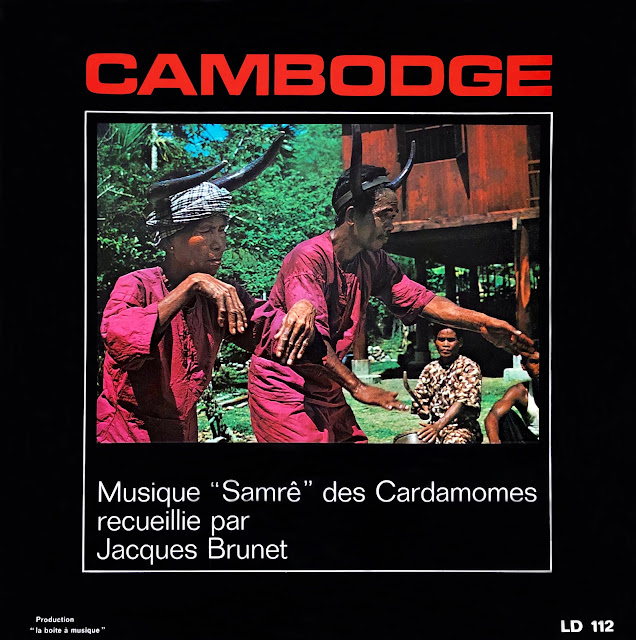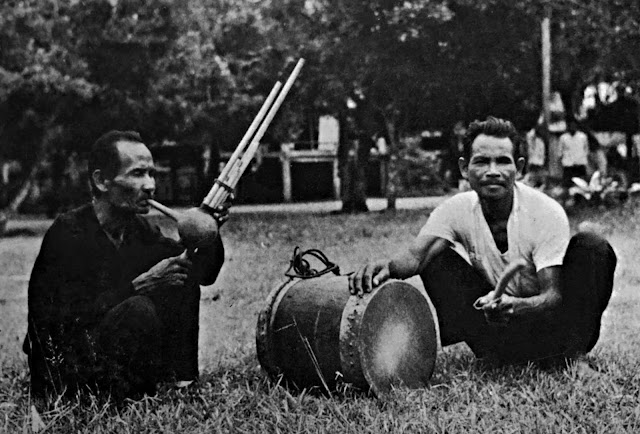Musique Samrê des Cardamomes – BAM LD 112, recorded by Jacques Brunet, 1964-1967 (LP)
The Cardamom Mountains, along Cambodia’s Pacific coast, are home to the Samrê (also known as the Samray and Pör) people. Difficult to access and covered in dense tropical forests, for centuries the region shielded their culture and way of life from external influences.
"In this hostile dense forest environment, the Samray express a sadness and nostalgia that appears throughout their musical improvisations when, in the evening, a hoarse voice suddenly breaks through the silence to invoke Invisible Powers, answered by a mouth organ weaving a delicate accompaniment."*
Jacques Brunet was the first to record their music, between 1964 and 1967, in three different areas of the Cardamom Mountains. The resulting anthology captures a vibrant, refined and sophisticated music that was soon to disappear.
These inspired musical fragments, featuring voices, khim mouth organ and drum, are all performed to accompany dancing (except lullaby B4) in rituals or festivities. Deep, melancholic, haunting and poetic musics with slow lingering tempos.
Les Monts Cardamomes, le long de la côte Pacifique du Cambodge, abritent les Samrê (également appelés Samray ou Pör). Difficile d'accès et recouverte de forêts tropicales denses, la région avait depuis des siècles protégé leur mode de vie et leurs cultures contre les influences extérieures.
“ Dans ce milieu hostile qu'est la forêt dense, les Samray ont acquis
un sentiment de tristesse et de nostalgie qui apparaît tout au long des
improvisations musicales lorsque, le soir tombant, une voix éraillée surgit
tout à coup du silence pour invoquer les Puissances Invisibles tandis qu'un
orgue à bouche module un délicat accompagnement. ”*
Jacques Brunet fut le premier à enregistrer leur musique, entre 1964
et 1967, dans trois contrées différentes des Monts Cardamomes. L'anthologie qui
en résulte nous offre une musique raffinée, sophistiquée et pleine de vitalité sur le point
de disparaître.
Ces fragments musicaux inspirés présentent des voix, de l’orgue à bouche
khim et du tambour, joués pour accompagner des danses (sauf la
berceuse B4) dans le cadre de rituels ou de festivités. Des musiques profondes,
mélancoliques, lancinantes et poétiques aux tempos lents.
I – The Pörs from Sre-Tang-Yor in the province
of Pursat
Living in a dense forest populated with many wild beasts,
like bears, snakes, "Their songs thus quite naturally address the
innumerable invisible forces which surround them."*
A1 Mouth organ solo by Kay Toeuk.
Recorded
in the village of Tuol Kruos, January 18, 1967.
A2
Ta Ngay Banboy – Singing, dancing
and offerings made to invoke the Spirit of the Forest to request its protection
and blessings.
Vên Dam and Boeun Tear, voices, In
Theang, mouth organ.
Recorded
in the village of
Peam Prus, March 17, 1965.
A3 Suang Pong Song Throch
(Dance of peacocks and wild oxen) – Rites for lunar festivals and religious
ceremonies held in the monastery.
Vên Dam and Boeun Tear, voices; Kay Toeuk, mouth organ; Chhuon Thâng, drum.
Recorded in the monastery of Peam Prus, October 30, 1964.
Vên Dam and Boeun Tear, voices; Kay Toeuk, mouth organ; Chhuon Thâng, drum.
Recorded in the monastery of Peam Prus, October 30, 1964.
II – The Pörs from Kranhung
in the Battambang province
"This is where tradition
is the most lively,"
A4 Bât An Choan Hal – Entertainment music often performed during marriage celebrations.
Suon and Msey, voices; Andan, mouth
organ.
Recorded in the village of Ta-Tok à
Kranhung, December 28, 1966.
Male singer:
"I look at the gray sky and the
mountain drowning in the mist,
The clouds veil your country, my little
Sdoeung,
When I wake up, everything is swimming
in the mist,
The clouds completely veil the country
of my dearest Sdoeung.
Wait for the sweetness of the night, my
dear,
Wait for the midnight sweetness,
I will consult your heart, I will ask
your soul."
Female singer:
"I contemplate the gray sky and
the mountain drowning in the mist,
I contemplate the gray sky and the
mountain drowning in the mist,
The clouds completely veil the country."*
B1
Moköy (funeral song)
Same
musicians and recording date as A4.
B2
Sneng Ansong (dance of the banteng ox
horns)
Ta-Prak, voice; unknown mouth-organ
player.
Recorded in the village of Ta-Tok à
Kranhung, December 28, 1966.
III
– The Pörs from the rice
fields at the foot of the mountains
B3
Pör Loeu (The Pör of the mountains) – Dance ceremonies to
invoke the souls of former kings.
Un Sây, voice; Nhék Ean, mouth organ; Un Diep, drum.
Recorded in Babaur, October 24, 1964.
Recorded in Babaur, October 24, 1964.
B4
Bât Bampé (lullaby)
Un Sây, voice; Nhék Ean, mouth organ.
Recorded
in Ang-Chan-Roung, Babaur, February 14, 1965.
*All
quotes and information here are from the French booklet written by Jacques
Brunet, also included in the downloads.
Download
From 1963 to 1982, Jacques Brunet, a concert pianist turned musicologist, made a series of recordings of traditional music from South-East Asia, via his many explorations of Cambodia, Laos, Thailand, Burma, Malaysia and Indonesia. We owe Brunet tremendous gratitude for mapping out the vanishing traditional musics in these countries and the outstanding musical quality of his many releases.
Please help me purchase important traditional records to pursue my global curation project and share the best finds with you on this blog:









Wow, so much good stuff here. Thank you again!
ReplyDeleteTeşekkürler...
ReplyDelete